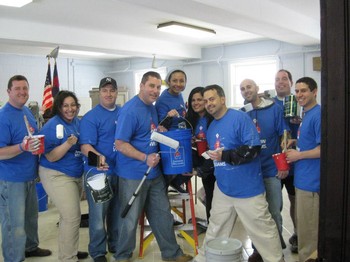Nearly a year and a half after Hurricane Sandy, the work of rebuilding in Bergen County, N.J., still seems daunting and never-ending. But the contributions of one small church have made a world of difference.
While the devastation of the shore towns on the East Coast has been the focus of much news coverage, Bergen County’s losses have not been in the spotlight as much. Although the area is 30 miles from the coast, its flat, marshy terrain lies on the Hackensack River. During Sandy, a 15-foot-high wall of seawater came up the river and flooded the entire area.
Homes, cars, public buildings and First Presbyterian Church in the small town of Moonachie (population 2,700), were damaged by the seawater.
“Right after the storm and for several months afterward, there were no public spaces,” said Tess Tomasi, project manager for Bergen Voluntary Organizations Active in Disaster/Hurricane Sandy Long Term Recovery Center, the county’s recovery effort.
In fact, Moonachie’s city hall has still not been reopened. So how do you regroup and get about the work of recovery if you don’t even have a space for people to assemble? Tomasi said the former pastor of First Presbyterian, the Rev. Kimberly Chastain, was heavily involved in the recovery effort and stepped in with the solution.
“Her own church was flooded, but also people that she served — the congregation — they were all flooded. They all received damage from the hurricane. So she offered the space to us,” Tomasi said. “It’s the only church in Moonachie, so you step up. It’s just what people do. They step up.”
Because the church was also damaged, the first step was to repair it. The building essentially had to be gutted and rebuilt. Through insurance, grants, volunteer labor and donations, the church was repaired and ready for use by last March.
“Basically it’s the headquarters for all of the recovery work. There are some 40 or 50 organizations that have all been involved or are currently involved and there aren’t too many that had space in the area,” Tomasi said.
The church building gives agency representatives a place to meet with clients and do administrative work, important for many who may be 30 miles or more away from their offices. It also serves as a walk-in center, which allows multiple agencies to have representatives available all in one place on a walk-in basis for residents.
“This is the hub of all the financial activity and support activity,” said Paul Talarico, moderator for the Presbytery of the Palisades, of which the Moonachie church is a member. “It houses the case managers, administrative staff and all that, so that Moonachie church, which is indeed a small congregation, is the one that’s taking care of that end of the business. This is how we do things. From the ground level up.”
Having a presence in the local community is important, Talarico said.
“It also cuts down on the expenses so more money is liberated to be able to go towards the people who were adversely affected by the storm rather than putting that into renting offices someplace,” he said.
It’s also an important factor for the local residents, all of whom lost their cars in the flood. While some have gotten new cars since the storm, others still arrive at the church on foot.
“Clients can find us. They don’t have to travel far. We’re right in their neighborhood,” Tomasi said. “We make it one-stop shopping, and the walk-in center allowed us to do that. If we didn’t have a physical presence here, we would have had people having to run around to different towns, meet with different people, fill out this application, go here, go there, but now they come to one place.”
Almost 900 families have come to the church looking for recovery assistance. Tomasi’s agency provides case management, rebuilding help, financial assistance and mold remediation. The agency also hosts workshop and training sessions and provide legal assistance through volunteer lawyers.
The walk-in center is expected to remain at least through July, as it provides needed support, even for those who have already navigated much of the recovery process.
“People think that this is over with. It’s not. There are systems in these homes that are now failing 16 months later because of the corrosion from salt water,” Talarico said. “It’s like it never stops. Small churches can do a lot. Individuals do a lot.”
The walk-in center has been critical in relieving stress and helping clear up the complexities of the recovery process, Talarico said.
“Even to this day, there are thousands of people that are displaced, their houses are ruined, motor vehicles, the usual, legal documents, you name it, all the trauma that goes along with that,” he said. “Just to navigate through this crazy alphabet soup of agencies, how you qualify, where you have to go, you have to apply for this one first and get rejected before you go to that one. All the stuff that can drive people crazy and make them discouraged.”
After witnessing the success of the walk-in center in Moonachie, Tomasi highly recommends such a system for other disaster-stricken areas. It also makes the perfect contribution for a small congregation wondering how to best contribute to disaster recovery.
“We’re in touch with all the other long-term recovery groups and a lot of them don’t have a walk-in center,” Tomasi said. “It’s something other congregations can do. This little congregation is making this tremendous contribution. Without this piece our whole operation wouldn’t be where it is today.”
Toni Montgomery is a freelance writer in Statesville, N.C., where she is also secretary for First Presbyterian Church.

